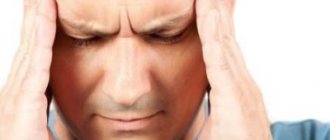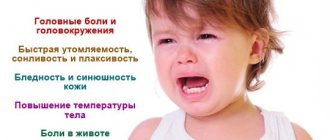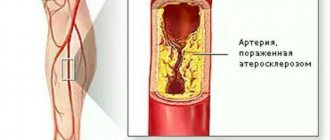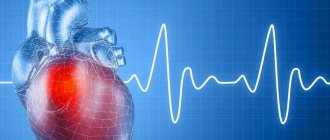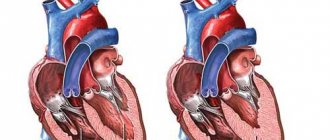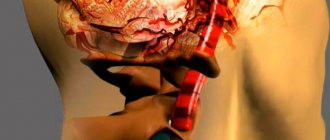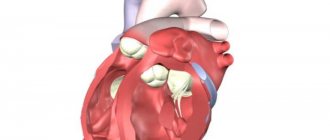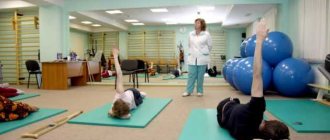Torsion dystonia
is a progressive neurological disease, the main syndrome of which is uncontrolled tonic contractions of various muscle groups, leading to the development of pathological postures. Accompanied by various variants of hyperkinesis, it can lead to curvature of the spine and joint contractures. Diagnosis is based on the exclusion of other pathologies and secondary torsion dystonia. Treatment is carried out with antiparkinsonian drugs, anticonvulsants, antispasmodics, B vitamins. Surgical treatment is possible - stereotactic destruction of subcortical structures.
Torsion dystonia
Torsion dystonia (from Latin “torsio” - twisting) is a chronic pathology of the nervous system, leading to tonic muscle disorders with the formation of aphysiological postures and the occurrence of hyperkinesis. The first detailed description of the disease dates back to 1907, but at that time it was classified as hysterical neurosis. The organic nature of torsion dystonia was proven by G. Oppenheim in 1911, but even after that, for a long period its nosological affiliation was the subject of debate, and its pathogenesis still remains unstudied.
Torsion dystonia can be observed at different age periods, but most often debuts before the age of 20; 65% of cases occur in the first 15 years of life. The occurrence in various populations ranges from 1 case per 160 thousand people. up to 1 case per 15 thousand people, on average - 40 cases per 100 thousand population. Steady progression, leading to disability in young people, and the lack of effective pathogenetic therapy make torsion dystonia an urgent problem of modern neurology.
Causes of torsion dystonia
The etiology and pathogenetic mechanism that results in torsion dystonia have not been studied to date. Idiopathic and symptomatic cases of this pathology are known. With the development of molecular genetic research, it became clear that idiopathic torsion dystonia is hereditary. Data have been obtained on various types of its inheritance: autosomal recessive and autosomal dominant. Moreover, in the second case, the disease manifests itself at a later age and has a milder course. At the same time, sporadic variants are described in the literature. Symptomatic torsion dystonia is observed with intracerebral tumors, Huntington's chorea, epidemic encephalitis, Wilson's disease, traumatic brain injury, and cerebral palsy.
Presumably, torsion dystonia is associated with a violation of dopamine metabolism. When examining patients, elevated levels of dopamine hydroxylase in the blood are often detected. The dominant pathogenetic theory is the idea that tonic disorders in this disease are caused by a disorder of subcortical regulation. This is supported by pronounced morphological degenerative changes in the subcortical nuclei (subthalamic, basal, red, substantia nigra), often detected in patients.
Classification of torsion dystonia
The focal form is characterized by tonic spasms of individual muscles. Focal forms include: idiopathic blepharospasm - closure of the eyelids caused by tonic spasm of the orbicularis oculi muscle; oromandibular dystonia - contraction of the muscles of the masticatory group, tongue, cheeks and mouth; spastic dysphagia - difficulty or inability to swallow; spasmodic dysphonia - a disorder of voice production due to tonic contraction of the vocal muscles; writer's cramp - involuntary contraction of the hand muscles, causing writing impairment; neck muscle spasm; foot spasm.
Multifocal form
- represents various combinations of focal forms.
Segmental form
- involuntary contraction of several adjacent muscle groups.
Hemidystonia
- involuntary tonic contraction covers the muscles of half the body.
Generalized form
- uncontrolled tonic contractions, covering almost all muscles of the body.
Symptoms of torsion dystonia
As a rule, torsion dystonia debuts with periodically occurring tonic focal spasms, observed mainly when the muscle group affected by dystonia is loaded. For example, at the beginning of its development, writer's cramp appears only during writing. Involuntary spastic contractions correspond to uncontrolled motor acts (hyperkinesis). The latter can be athetoid, choreatic, myoclonic, tonic, hemiballic, tic-like or tremor-like in nature. In the distal parts of the limbs they are less pronounced than in the proximal ones. Rotational movements of the torso or limbs along their longitudinal axis are typical.
Pathognomonic is a change in the intensity of spastic postures and involuntary motor acts in accordance with the functional activity and position of the body, as well as the emotional state of the patient. Corkscrew-like movements of the torso are observed mainly during walking, hyperkinesis of the limbs - when trying to perform a purposeful action. During sleep, the disappearance of all tonic pathological manifestations and hyperkinesis is observed. The ability of patients to adapt to the emerging movement disorders, temporarily reduce the severity of hyperkinesis, maintain self-care and perform complex motor acts (for example, dancing) is noted.
Frequent muscle contractions can cause the development of their hypertrophy, long-term spasm is a connective tissue replacement of muscle tissue with the formation of shortening of the muscle and a persistent decrease in its ability to stretch. Long-term forced position of a limb during muscle spasm leads to degenerative processes in articular tissues and the formation of joint contractures. Tonic spasms of the back muscles cause curvature of the spine: lumbar lordosis, scoliosis or kyphoscoliosis. In later stages, spasms of the trunk muscles can cause respiratory problems.
In some cases, torsion dystonia begins with local forms, which gradually transform into a generalized version. The latter is characterized by an elaborate gait with swaying, periodic adoption of an abnormal pose and freezing in it. In some patients, the disease has a stable course with the preservation of isolated local manifestations and without generalization of the dystonic process. A similar course is observed mainly in cases of late onset (in the period from 20 to 40 years).
Therapy methods
Treatment of torsion dystonia includes conservative and surgical options. In addition, a course of therapeutic exercises and hydrotherapy is prescribed.
Conservative treatment includes drugs of various effects:
- antipsychotic drugs;
- tranquilizers;
- vitamin therapy;
- adrenergic blockers;
- anticonvulsant drugs;
- anticholinergics, etc.
If drug treatment does not help, surgery is prescribed. An exception is if the patient has severe diseases of the internal organs, as well as blood diseases. In the later stages, these diseases are not contraindications.
In the later stages of development of torsion dystonia, the prognosis is not comforting, since such patients often die from intercurrent diseases. After surgical treatment, muscular dystrophy and hyperkinesis decrease or disappear altogether.
With timely and adequate treatment, patients partially recover: they can walk, perform the necessary actions and take care of themselves. In 70% of cases, patients experience improvement after surgery.
When secondary torsion dystonia occurs, surgical treatment gives a positive result, and regression of hyperkinesis and spasms is observed.
After drug or surgical treatment, the patient must always comply with medication support. Relatives of such a patient should be monitored. Parents with a child with dystonia are advised to refuse further childbearing.
Torsion dystonia is a chronic progressive disease of the nervous system, clinically manifested by changes in muscle tone and involuntary, tonic contractions of the muscles of the trunk and limbs.
Etiology and pathogenesis
There are idiopathic (familial) torsion dystonia and symptomatic. The type of inheritance for idiopathic torsion distance is both autosomal dominant and autosomal recessive. Symptomatic torsion dystonia occurs in hepatocerebral dystrophy, Huntington's chorea, brain tumors, epidemic encephalitis, and cerebral palsy. There are indications that a violation of dopamine metabolism is important in the pathogenesis of hereditary torsion dystonia. When examined in these patients, an increase in dopamine beta-hydroxylase in the blood serum is detected.
Pathomorphology
Dystrophic changes are found mainly in small neurons in the area of the shell of the lentiform nucleus, less often in other basal ganglia.
Clinical picture
The disease develops gradually, in 2/3 of cases under the age of 15 years. In childhood, the first symptoms of the disease may be gait disturbance, spastic torticollis; in adults, primary generalized forms are more common. As a result of a violation of the ratio of the functions of synergistic and antagonistic muscles, violent long-term tonic contractions of the muscles of the trunk, head, pelvic girdle, and limbs occur, usually of a rotatory nature, combined with athetoid movements in the fingers. It seems that the muscles are constantly contracting to overcome the action of the antagonists. The resulting postures, even the most uncomfortable ones, persist for a long time. Hyperkinesis intensifies with excitement, active movements, and disappears during sleep. Muscle tone, which changes in the limbs, is often somewhat reduced. The joints are loose. Gradually, as the disease progresses, the patient's posture becomes permanently dystonic, with increased lumbar lordosis, hip flexion, and medial rotation of the arms and legs. Depending on the prevalence of dystonic phenomena, local and generalized forms of the disease are distinguished. With local dystonic symptoms, tonic contraction of individual muscle groups occurs, voluntary movements are disrupted, and abnormal posture occurs. Such symptoms include spasmodic torticollis, writer's cramp, oromandibular dystonia (opening and closing of the mouth and involuntary movements of the tongue), blepharospasm, buccofacial, buccolingual dystonia, choreoathetosis.
Course and prognosis
The disease in most cases progresses steadily. Sometimes there are different durations of remission. Profound disability of patients quickly occurs and death occurs, especially in the generalized form.
Treatment
long-term, symptomatic. Combinations of anticholinergics and sedatives are used; in some cases, levodopa is effective. Haloperidol or reserpine is also prescribed. Very rarely resort to stereotactic operations on the subcortical nuclei.
Torsion dystonia is deforming muscle dystonia, dysbasia lordotica progressiva. A chronic progressive disease, which is characterized by slow tonic hyperkinesis of the muscles of the trunk and limbs and peculiar changes in muscle tone, leading to the appearance of pathological postures.
There is a distinction between torsion distance as an independent disease and torsion-dystonic syndrome, which can be a manifestation of various diseases (hepato-cerebral dystrophy, epidemic encephalitis and other neuroinfections, intoxication, consequences of birth trauma, arteriosclerosis).
Torsion dystonia is a hereditary disease with a heterogeneous type of transmission. The disease can be inherited either dominantly or recessively. Dominant inheritance is more common.
An important role in the pathogenesis of torsion dystonia is played by disturbances in the central regulation of muscle tone, as a result of which the mechanism of reciprocal innervation changes and a pathological “spasm of antagonists” occurs, which leads to the development of peculiar hyperkinesis and postural disorders.
The primary biochemical defect associated with hereditary pathology in torsion dystonia is not yet known.
In the brain, degenerative changes are detected in the subcortical formations.
There are generalized and local forms of torsion dystonia.
Generalized form
characterized by the presence of pronounced widespread tonic hyperkinesis, covering the muscles of the trunk, neck, and limbs. As a result of these hyperkinesis, the body is bent in different directions, bent according to the type of rotation around the longitudinal axis. Frequently, bizarre curvatures of the spine occur, often with the formation of pathological lordosis. The head is sharply thrown back, tilted to the sides or forward, the limbs occupy various, often unusual, pretentious poses. Deformities and contractures in the joints gradually develop. Hyperkinesis increases sharply with voluntary movements, especially when walking. Hence one of the names of the disease is disbasia lordotica (from the Greek basis - walking, dys - denial). Despite this, patients can retain the ability to move independently for a long time. In a horizontal position and in a state of complete rest, violent movements decrease sharply, and in the initial stages of the disease disappear completely. There is no hyperkinesis during sleep. In some cases, in addition to slow tonic hyperkinesis, other types of violent movements may occur.
Changes in tone are characterized by a combination of extrapyramidal rigidity and hypotension and depend on the position of the body at the moment or on a certain posture. In advanced cases, muscle rigidity predominates in the trunk and limbs. The process may also involve the muscles of the face, tongue, pharynx, and intercostal muscles, which leads to disturbances in speech, breathing, and swallowing.
Local or limited
, a form of torsion dystonia, which is more common, is characterized by changes in tone and hyperkinesis, extending only to certain muscle groups or individual limbs. The legs often develop abnormal foot alignment, leading to changes in gait. Torsion-dystonic changes in the hands can cause the development of writer's cramp syndrome. One of the common forms of local torsion dystonia is spastic torticollis (torticollis spastica). In this condition, tonic hyperkinesis in the muscles of the neck leads to its curvature and forced rotation of the head. However, you should always remember that local manifestations of the disease can be the initial symptom of slowly progressing generalized torsion dystonia.
The first symptoms of the disease usually appear between the ages of 5 and 15 years. The generalized form begins at an earlier age, while the onset of symptoms of local torsion dystonia may occur at a more mature age (from 20 to 40 years). Subsequently, the disease slowly but steadily progresses. As a rule, the disease is more severe in families with a recessive type of inheritance.
Torsion dystonia should be differentiated from symptomatic forms of the disease, which can occur in a number of pathological conditions. Exogenously caused phenocopies of the disease (consequences of birth trauma, neuroinfections, intoxications) are distinguished by the non-progressive nature of the disease, pronounced asymmetry of the pathological process, and the presence of other (except extrapyramidal) symptoms of damage to the nervous system.
Torsion dystonia should be distinguished from hepatocerebral dystrophy, mainly from its early, rigid-arrhythmohyperkinetic form, in which similar neurological symptoms are often observed. Hepato-cerebral dystrophy is also characterized by the onset of the disease in childhood and steady progression. However, unlike torsion dystonia, hepatocerebral dystrophy has severe liver damage, which in its early form is usually detected by clinical or laboratory research methods. A characteristic feature characteristic only of hepato-cerebral dystrophy are specific changes in copper metabolism and the presence of the Kayser-Fleischer corneal ring. Patients with hepato-cerebral dystrophy have mental disorders, which, as a rule, are absent in torsion dystonia.
Torsion dystonia differs from double athetosis in its progressive course, later onset of the disease (with double athetosis, the initial signs of the disease appear more often in the first weeks or months of the child’s life), the spread of hyperkinesis mainly to the muscles of the trunk and proximal limbs, while with double athetosis slow “worm-like “Hyperkinesis affects mainly the distal parts of the extremities.
Diagnosis of torsion dystonia
In the neurological status, attention is drawn to the rigidity of individual muscle groups with the preservation of tendon reflexes, the absence of a decrease in muscle strength and sensory disorders; intellectual-mnestic safety of patients.
The main diagnostic task for a neurologist is to differentiate idiopathic torsion dystonia from secondary torsion-dystonic syndromes. The latter are usually accompanied by accompanying dystonia symptoms of damage to the nervous system, autonomic disorders, sleep disorders, etc. In terms of differential diagnosis, REG or USDG of the vessels of the head, EEG, Echo-EG, CT or MRI of the brain are performed.
Torsion dystonia differs from hepatocerebral dystrophy in the absence of pigment deposits in the cornea (Kayser-Fleischer ring), liver damage, and a decrease in blood ceruloplasmin. From epidemic encephalitis - the absence of an acute period and such manifestations of encephalitis as convergence disorder and diplopia, sleep disorder, autonomic dysfunction, etc.
Prognosis and prevention
The prognosis for hereditary torsion dystonia is unfavorable.
The disease will progress slowly over many years. In the absence of treatment, by about the age of forty, intercurrent diseases develop, which lead to death.
If torsion dystonia is a consequence of another disease (for example, brain cancer), then the prognosis depends on the course of this disease.
If a child develops symptoms of torsion dystonia in a family, childbearing should be avoided in the future. You should also take B vitamins for prevention.
There are foods that contain large quantities of B vitamins, especially B1 and B6, which are necessary for the normal functioning of the nervous system. These are legumes, walnuts, buckwheat, corn, beef, cabbage, eggs.
Thus, torsion dystonia is a disease in which the muscles of the trunk, neck and limbs involuntarily contract, twisting the body around its axis. The cause of the disease is disturbances in the functioning of certain areas of the brain. The prognosis in the absence of treatment is unfavorable. To treat the disease, a set of measures is used, including exercises, medications and surgery.
Treatment of torsion dystonia
In conservative therapy, drugs are used to treat parkinsonism: combined decarboxylase inhibitor levodopa + carbidopa, anticholinergics trihexyphenidyl and dietazine, triperiden, selegiline, bromocriptine; centrally acting antispasmodics (diphenyltropin); a-DOPA in small doses; tranquilizers (diazepam); vitamins B1 and B6. When hyperkinesis is severe, baclofen, carbamazepine, and tiapride are used. Physical therapy and hydrotherapy are indicated. Treatment of secondary dystonia is based on treatment of the causative disease.
Surgical treatment is performed by a neurosurgeon and is indicated for progression of dystonia and disability. Stereotactic combined destruction of basal subcortical structures is carried out - the subthalamic zone and the ventrolateral thalamic nucleus. In local variants of dystonia, destruction is carried out contralateral to muscle disorders. In the generalized version, as a rule, surgical treatment is carried out in 2 stages: first, opposite to the most severe symptoms, and after 6-8 months. - on the second side. If rigidity is expressed symmetrically, then the dominant hemisphere is operated on first. In 80% of cases, after surgery, there is a significant improvement in the patients’ condition, which in 66% of cases persists for many years.
Forecast of torsion dystonia
Idiopathic torsion dystonia has a slowly progressive course. The outcome is determined by the time of its manifestation. An earlier debut leads to a more severe course and early generalization of dystonia with the development of deep disability. The death of patients is caused by intercurrent infections.
Surgical treatment significantly improves the prognosis. In most cases, after surgery, regression or complete disappearance of hyperkinesis and rigidity is observed; for a long period, patients retain the ability to self-care, are able to walk and perform other complex motor acts. Secondary torsion dystonia, if effective treatment of the disease is possible, has a favorable prognosis. In such cases, regression of spasms and hyperkinesis of varying severity is observed.
Forecast
The idiopathic form of the pathological process progresses extremely slowly. The prognosis directly depends on the timeliness of its detection and the age at which the onset occurred (the first signs appeared). A child suffering from the symptoms of this disease gradually loses the ability to care for himself. According to statistics, children are especially likely to develop a generalized type of dystonia. Death occurs due to complications that develop over time.
The symptomatic form of torsion dystonia, which arose against the background of other pathologies, has a fairly positive prognosis if the primary factor can be eliminated. If treatment of the underlying disease is successful, the severity of symptoms decreases.
Surgery can change the prognosis for the better. In many patients, the disease regresses, causing rigidity and hyperkinesis to decrease or disappear. Thanks to the help of a surgeon, patients will be able to carry out daily activities and take care of themselves independently for a long time.

